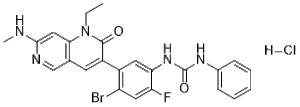This product is for research use only, not for human use. We do not sell to patients.

| Size | Price | Stock |
|---|---|---|
| 100mg | $650 | Check With Us |
| 250mg | $1250 | Check With Us |
| 500mg | $1875 | Check With Us |
Cat #: V3757 CAS #: 1442472-39-0 (free base) Purity ≥ 98%
Description: Ripretinib HCl (DCC2618; DCC-2618; Qinlock), the hydrochloride salt of DCC-2618, is an orally bioactive pan KIT and PDGFRA inhibitor approved in 2020 for the treatment of adults with advanced gastrointestinal stromal tumor.
References: KIT/PDGFR Inhibitor DCC-2618.
Publications Citing InvivoChem Products
Product Promise

- Physicochemical and Storage Information
- Protocol
- Related Biological Data
- Stock Solution Preparation
- Quality Control Documentation
| Molecular Weight (MW) | 546.83 |
|---|---|
| Molecular Formula | C24H22BrClFN5O2 |
| CAS No. | 1442472-39-0 (free base) |
| Storage | -20℃ for 3 years in powder formr |
| -80℃ for 2 years in solvent | |
| Solubility In Vitro | DMSO: >100 mg/mLr |
| Water: <1 mg/mLr | |
| Ethanol: 10 mg/mL | |
| SMILES Code | O=C(NC1=CC=CC=C1)NC2=CC(C3=CC4=C(N(CC)C3=O)C=C(NC)N=C4)=C(Br)C=C2F.[H]Cl |
| Synonyms | DCC-2618 hydrochloride; DCC 2618 HCl; DCC2618; Ripretinib hydrochloride |
| Protocol | In Vitro | Ripretinib (DCC-2618) suppresses phosphorylation of KIT and decreases the expression of phosphosphorylated (p)STAT5, pAKT and pERK1/2 in neoplastic mast cells. Ripretinib inhibits the growth of ROSAKIT K509I cells with an IC50 of 34 ± 10 nM, and also induces apoptosis in these cells. Ripretinib (0.1-1.0 μM) inhibits IgE-dependent histamine release from basophils and spontaneous tryptase release from neoplastic mast cells, and also counteracts growth and survival of leukemic monocytes and blast cells at 0.01-5 μM. |
|---|
| Solvent volume to be added | Mass (the weight of a compound) | |||
|---|---|---|---|---|
| Mother liquor concentration | 1mg | 5mg | 10mg | 20mg |
| 1mM | 1.8287 mL | 9.1436 mL | 18.2872 mL | 36.5744 mL |
| 5mM | 0.3657 mL | 1.8287 mL | 3.6574 mL | 7.3149 mL |
| 10mM | 0.1829 mL | 0.9144 mL | 1.8287 mL | 3.6574 mL |
| 20mM | 0.0914 mL | 0.4572 mL | 0.9144 mL | 1.8287 mL |
This equation is commonly abbreviated as: C1 V1 = C2 V2
- (1) Please be sure that the solution is clear before the addition of next solvent. Dissolution methods like vortex, ultrasound or warming and heat may be used to aid dissolving.
- (2) Be sure to add the solvent(s) in order.




































